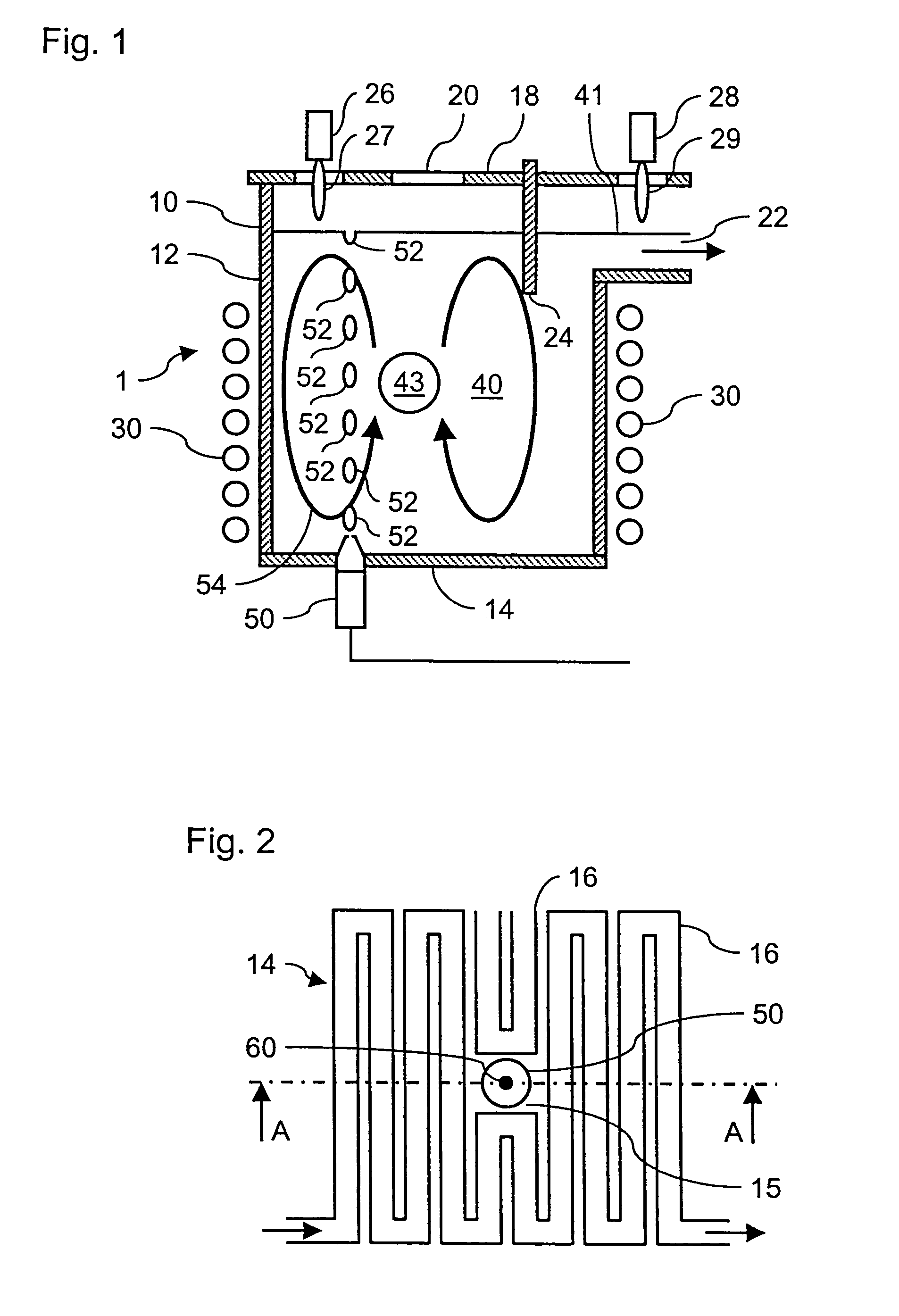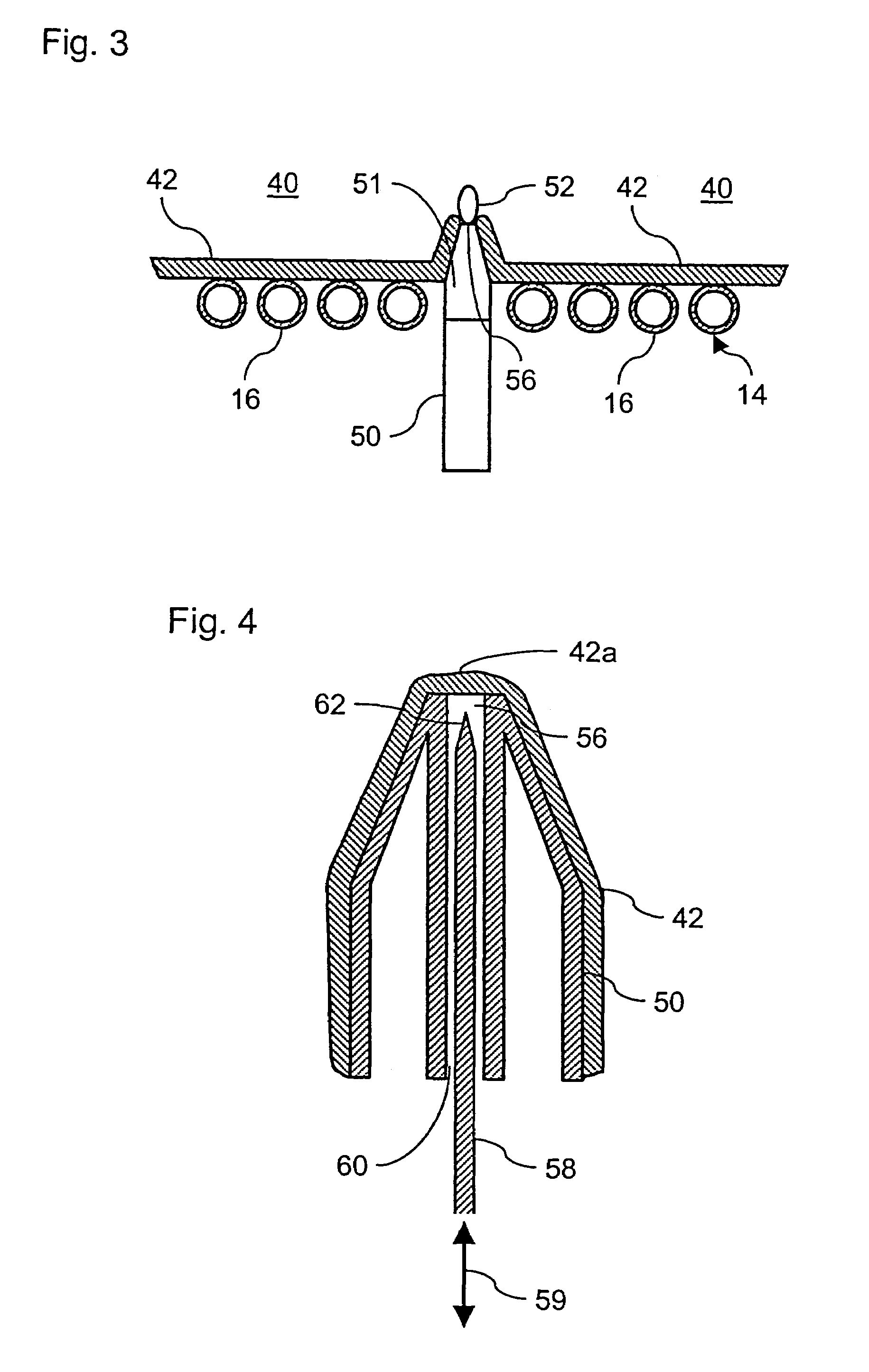Device and method for melting a substance with the occurrence of a low level of contamination
a technology of contamination and melting device, which is applied in the direction of glass reforming device, glass tempering device, glass pressing device, etc., can solve the problems of reducing the melting temperature of the substance, so as to improve the melting temperature and throughput , the effect of increasing the melting capacity
- Summary
- Abstract
- Description
- Claims
- Application Information
AI Technical Summary
Benefits of technology
Problems solved by technology
Method used
Image
Examples
first embodiment
[0058]FIG. 1 shows the apparatus 1 according to the invention for melting glass, having a cooled, e.g. water-cooled, crucible or melting crucible 10. An emitting device for emitting electromagnetic radiation, in the form of a coil arrangement 30, is arranged around the crucible 10. High-frequency power is introduced into a melt 40, for example comprising lead silicate glass, by means of the coil arrangement, so that the melt 40 is heated. A high frequency of approximately 250 kHz to approximately 400 kHz at an emission power of approximately 200 kW to approximately 300 kW or higher is used. The temperature of the melt is in the range from 1200° C. to 2000° C.
[0059]The crucible 10 comprises a water-cooled annular wall section 12 and a water-cooled base 14. The wall section 12 and the base 14 together form the cooled wall of the crucible 10 and each comprise metal tubes 16 which are arranged in meandering form and are spaced apart from one another, as can be seen most clearly from FIG...
second embodiment
[0074]FIG. 7 shows the apparatus 101 according to the invention, with an alternative device 150 for mixing and homogenizing the melt 40. Glass batch which has been formed into pellets, coated pills and / or beads 156 is introduced, via a conveyor belt 154, into the melt 40 through the opening 20. The glass beads 156 comprise an outer boundary region 158 and an inner core region 160. The boundary region 158 substantially comprises glass of the same composition as the melt 40. The core region 160 comprises a substance which releases a gas or gas bubbles 152 in the melt when the boundary region 158 has melted. The substance in the core region 160 may comprise a gas, a liquid, e.g. water, or a solid material, e.g. a salt, which by interacting with the hot melt 40 release the gas bubbles 152.
[0075]The fact that the glass beads 156 sink in a left-hand section 40a of the melt and the fact that the gas bubbles 152 rise up in a right-hand section 40b of the melt 40 result in a substantially an...
third embodiment
[0076]FIG. 8 shows the apparatus 201 according to the invention, in which batch bodies 256 which have been pressed into the form of rods are introduced into the melt 40 by means of a mixing and homogenization device 250. The bodies 256 in rod form are, for example, shaped in the style of propellers and rotate as they sink within the melt 40, with the bodies 256 being melted at the same time, so as to generate flow phenomena in the melt 40.
PUM
| Property | Measurement | Unit |
|---|---|---|
| melting temperatures | aaaaa | aaaaa |
| melting temperatures | aaaaa | aaaaa |
| frequency | aaaaa | aaaaa |
Abstract
Description
Claims
Application Information
 Login to View More
Login to View More - R&D
- Intellectual Property
- Life Sciences
- Materials
- Tech Scout
- Unparalleled Data Quality
- Higher Quality Content
- 60% Fewer Hallucinations
Browse by: Latest US Patents, China's latest patents, Technical Efficacy Thesaurus, Application Domain, Technology Topic, Popular Technical Reports.
© 2025 PatSnap. All rights reserved.Legal|Privacy policy|Modern Slavery Act Transparency Statement|Sitemap|About US| Contact US: help@patsnap.com



